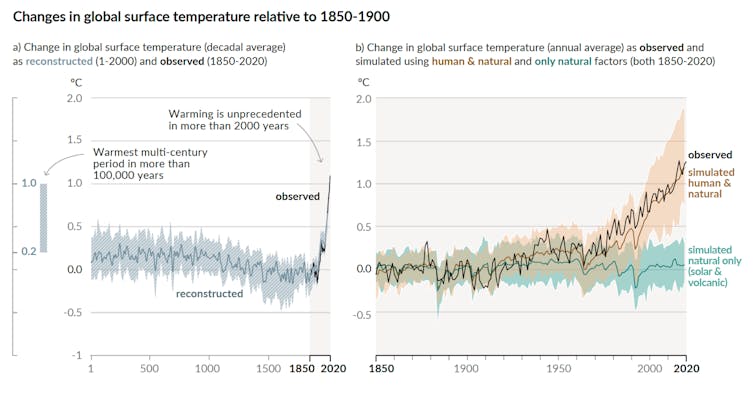How Many Climate Scientist Believe In Climate Change
Despite the overwhelming testify, it's still common to see politicians, media commentators or social media users cast dubiety on the role of humans in driving climate change.
Just this denialism is now almost nonexistent among climate scientists, as a written report released this month confirms. US researchers examined the peer-reviewed literature and found more 99% of climate scientists now endorse the testify for man-induced climate change.
That'due south fifty-fifty higher than the 97% reported past an influential 2013 written report, which has get a widely cited statistic by both climate change deniers and those who accept the evidence.
Why has the needle evidently shifted even more than firmly in favour of the testify-based consensus? Or, to put it another style, what happened to the 3% of researchers who rejected the consensus of man caused climatic change? Is this modify purely considering of the growing weight of bear witness published over the by few years?
Unpicking the polls
Nosotros must first enquire whether the two studies are directly comparable. The answer is yes. The latest report has reexamined the literature published since 2012, and is based on the aforementioned methods as the 2013 study, albeit with some of import refinements.
Baca juga: Consensus confirmed: over 90% of climate scientists believe we're causing global warming
Both studies searched the Web of Science database – an independent worldwide repository of scientific paper citations – using the keywords "global climatic change" and "global warming". However, the recent report added "climate change" to the other ii keyword searches, because the authors establish that about climate-contrarian papers would not have been returned with just the 2 original terms.
The 2013 study examined 11,944 climate inquiry papers and constitute almost ane-tertiary of them expressed a position on the cause of global warming. Of these 4,014 papers, 97% endorsed the consensus position that humans are the cause, 1% were uncertain, and 2% explicitly rejected it.
A 2015 review examined 38 climate-contrarian papers published over the preceding decade, and identified a range of methodological flaws and sources of bias.
One of the reviewers commented that "every single i of those analyses had an error – in their assumptions, methodology, or analysis – that, when corrected, brought their results into line with the scientific consensus".
For example, many of the contrarian papers had "cherrypicked" results that supported their conclusion, while ignoring important context and other data sources that contradicted it. Some of them simply ignored primal physics.
The 2015 reviewers likewise made the important point that "science is never settled and that both mainstream and contrarian papers must be subjected to sustained scrutiny". This is the cornerstone of the scientific method, and few if any climate scientists would disagree with this statement.
Separating the homo influence from the natural
The recently published Intergovernmental Panel for Climate Change (IPCC) Synthesis Report, says "it is unequivocal that man influence has warmed the atmosphere, sea and state", and warns that the Paris Agreement goals of one.5℃ and 2℃ to a higher place pre-industrial levels will be exceeded during this century without dramatic emissions reductions.
In reaching this conclusion, it is important to distinguish between changes caused by human activities altering the atmosphere's chemistry, and climate variability caused by natural factors.
These natural variations include modest changes in the Sun's energy output due to sunspots and solar flares, infrequent volcanic eruptions, and the furnishings of El Niño conditions patterns in the Pacific Ocean.

Excluding these natural variations, Globe's surface temperature was by and large stable from virtually 2,000 to one,000 years ago. Later on that, the planet cooled by near 0.3℃ over several centuries, before the advent of fossil fuel-based industrialisation in the 1800s.
One written report identified 12 major volcanic eruptions from 100 to 1200 CE, compared with 17 eruptions from 1200 to 1900 CE. Hence, heightened volcanic activity over roughly the past 800 years was associated with a general global cooling before the industrial revolution.
Electric current rates of global warming are unprecedented in more than than 2,000 years and temperatures now exceed the warmest (multi-century) period in more than 100,000 years. Global average surface temperature for the decade from 2011-20 was about 1.1℃ higher than in 1850-1900. Each of the past four decades has been warmer than any preceding decade since 1850, when reliable atmospheric condition observations began.
Baca juga: 99.999% certainty humans are driving global warming: new report
Researchers tin split up human and natural factors in the modernistic global temperature tape. This involves a process called hindcasting, in which a climate model is run backwards in fourth dimension to simulate human and natural factors, and so compared with the observed data to see which combination of factors near accurately recreates the real globe.
If man factors are removed from the data set and only volcanic and solar factors are included, then global average surface temperatures since 1950 should take remained similar to those over the preceding 100 years. Simply of course they oasis't.
The bear witness, and the scientific consensus on information technology, are both clearer than ever.
Source: https://theconversation.com/the-97-climate-consensus-is-over-now-its-well-above-99-and-the-evidence-is-even-stronger-than-that-170370
Posted by: allenundeng1969.blogspot.com


0 Response to "How Many Climate Scientist Believe In Climate Change"
Post a Comment